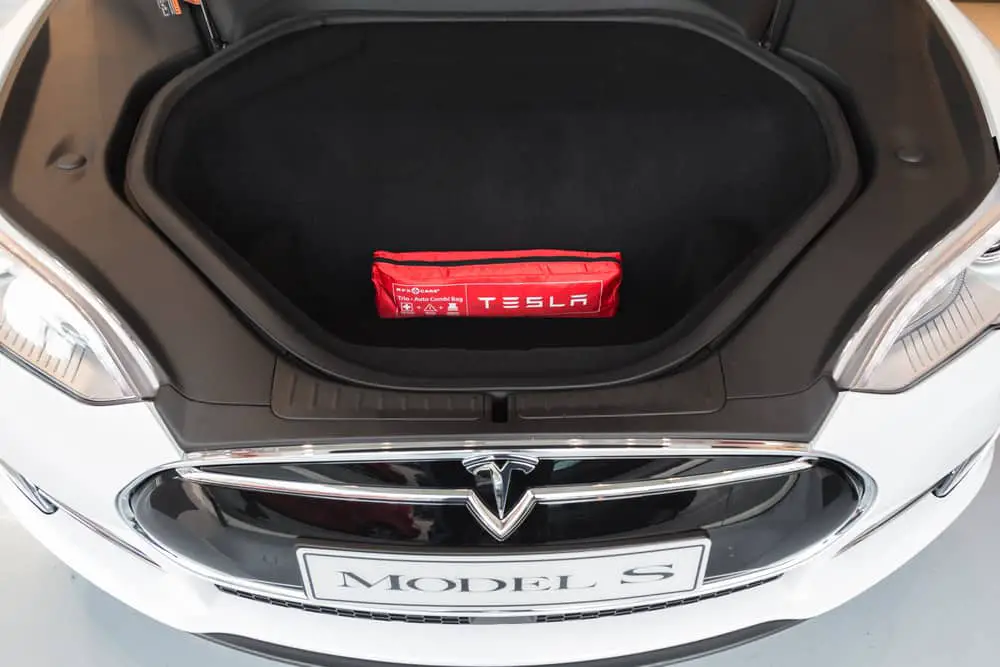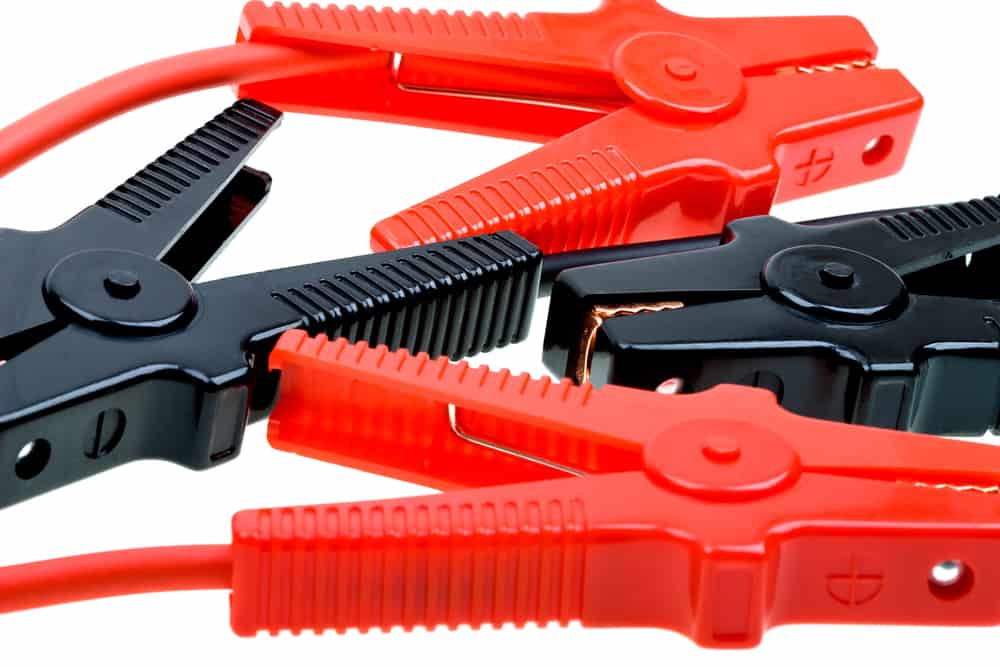Understanding Electric Vehicles and Tesla’s Battery System
Electric vehicles (EVs) are designed with a different power system compared to traditional internal combustion engine (ICE) vehicles. One of the key differences is the battery system in EVs, specifically in Teslas.
A Tesla has two battery systems: the main battery, which powers the electric drivetrain, and the auxiliary 12V battery, which powers the vehicle’s electronic components.
Quick Answer:
Yes, a Tesla can be jump-started but not in the traditional way gasoline cars are. Instead of the battery, you’re essentially jump-starting the 12V electronics system, which allows you to put the car into tow mode or neutral if needed. This process involves connecting a 12V power source to the 12V jump start terminals located under the hood. It’s crucial to follow Tesla’s specific instructions to avoid any damage, and remember, this won’t fix a depleted drive battery.
The main battery in Tesla models is a high-capacity lithium-ion battery pack designed to provide significant range and power output. On the other hand, the 12V auxiliary battery serves the same function as the traditional 12V battery in ICE vehicles, providing power to lights, infotainment, and other essential systems.
Why Jump Starting a Tesla Is Different
When it comes to jump-starting an ICE vehicle, the process involves connecting jumper cables between the dead 12V battery of the vehicle and a functioning 12V battery, generally from another vehicle.
However, jump-starting a Tesla is a different process due to its unique battery setup. Here are some of the differences:
- In a Tesla, jump-starting is generally focused on the auxiliary 12V battery rather than the main battery, as the latter is not directly involved in the process.
- It’s important not to connect the jumper cables to the main battery of the Tesla, as this can lead to damage or potential hazards due to the high voltage and capacity of the EV battery pack.
- Teslas have a specific location for connecting jumper cables, which is usually found near the 12V battery. The Tesla user manual provides instructions on accessing the jump-start connection points.
While there are some differences in the jump-starting process for Teslas, it is still possible to jump-start the 12V battery using a compatible 12V source, such as a portable jump starter or another vehicle’s 12V battery. However, it is always wise to consult the Tesla owner’s manual and follow the guidelines provided for a safe and successful jump-start.
Remember to keep all these aspects in mind when dealing with a Tesla and its battery systems. Although jump-starting a Tesla is different from traditional ICE vehicles, the process is still manageable with the proper knowledge and precautions.
Jump Starting a Tesla Safely
Preparation and Safety Tips
Before attempting to jump-start a Tesla, keep these things in mind:
- Ensure you have a pair of jumper cables ready.
- Briefly review the Tesla owner’s manual for any specific instructions for your model.
- Find a suitable car with a charged battery to assist you in the jump-starting process.
Step-By-Step Procedure
To jump-start your Tesla, follow these steps:
- Park the assisting vehicle close to the Tesla, but ensure they do not touch each other.
- Turn off both cars and disable any electronic devices.
- Open the hood of both vehicles and locate the batteries or battery jump-start terminals.
- Red positive (+) cable: Attach one end of the cable to the dead Tesla battery’s positive terminal or jump-start terminal, then attach the other end to the assisting vehicle’s battery positive terminal.
- Black negative (-) cable: Attach one end of the cable to the assisting vehicle’s battery negative terminal, and connect the other end to an unpainted metal surface in the Tesla, away from the battery.
- Start the assisting vehicle, and allow it to run for a few minutes.
- While the assisting vehicle is running, try to start your Tesla. Monitor the touchscreen in your Tesla for any error messages.
- If the battery level in your Tesla shows an increase, prepare to remove the jumper cables. Disconnect the cables in the reverse order they were attached, starting with the black negative (-) cable.
- Once your Tesla starts, allow it to run for some time to charge the battery.
Remember to consult your Tesla owner’s manual for any specific instructions and follow those as needed. Always prioritize safety and never attempt to jump-start a severely damaged or leaking battery, as it can be hazardous.
Tesla’s Internal Systems for Battery Management
Electric Vehicle Software and Onboard Computer
Tesla’s electric vehicles (EVs) contain sophisticated software and an onboard computer to manage their battery systems. The EV software is responsible for monitoring and adjusting the charging process, ensuring that the battery pack receives the correct amount of energy.
This software works in conjunction with the onboard computer, which continually monitors the battery’s state of charge, temperature, and overall health.
The onboard computer is essential for managing the electric power delivery and analyzing the energy consumption of the EV. It helps to extend the capacity and life of the battery pack and ensure optimal performance.
Maintenance and Warning Systems
Tesla’s maintenance system helps keep EVs operating safely and efficiently. The maintenance system monitors the vehicle’s health, checking for any potential issues that could impact battery performance. If a concern is detected, the onboard computer will display a warning message or alert the driver through mobile notifications.
Some of the warning systems for battery management in a Tesla include:
- Battery temperature: The system actively monitors the temperature of the battery pack and adjusts the cooling or heating to maintain optimal conditions.
- State of charge: To prevent overcharging or discharging, the onboard computer keeps track of the battery’s state of charge and limits the power as needed.
- Voltage monitoring: The onboard computer continuously monitors the voltage levels of individual battery cells to ensure they remain balanced and remain within safe limits.
In conclusion, Tesla’s internal systems for battery management play a vital role in maintaining the performance and longevity of the battery pack. With the combination of electric vehicle software, an onboard computer, and maintenance & warning systems, Tesla ensures that its EVs can deliver reliable battery power and energy to its users.
Alternative Solutions and Tesla Support
Tesla Roadside Assistance Services
In case your Tesla’s battery dies, Tesla provides Roadside Assistance Services as a first line of support. The service covers common on-road situations, such as:
- Towing to a nearby charging station or service center
- Flat tire change
- Jump starting a Tesla
To access this service, simply contact Tesla Support through their mobile app or phone number.
Portable Power Sources
For Tesla owners seeking alternative solutions, portable power sources can be used in some instances:
- External battery: A portable jump starter or an external battery can help charge the 12V battery of a Tesla vehicle. However, this solution is only effective if the main battery is not completely drained.
- Portable charging station: A portable EV charging station can be used to recharge your Tesla if you are away from a Supercharger or if the main battery has not completely died.
Remember to always consult your vehicle’s manual and Tesla Support for approved charging methods and equipment to maintain safety and avoid potential damage.
Keep in mind that jump starting a Tesla may not always be the most effective solution, especially if the main battery is fully discharged.
In such cases, it may be better to rely on Tesla roadside assistance or connect your vehicle to a charging station or Tesla Supercharger to recharge your car more efficiently and sustainably. Tesla is dedicated to clean energy, so they recommend using their network of charging solutions whenever possible.
Tesla Models and Related Information
Environmentally Friendly Aspects
Tesla is a pioneer in the field of electric vehicles (EVs), offering a range of environmentally friendly cars that contribute to clean transport. By removing the need for combustion engines, EVs such as those produced by Tesla significantly reduce greenhouse gas emissions and air pollution when compared to their gasoline-powered counterparts (ICE cars).
Tesla offers various models, including the Model 3, Model S, and others. These electric cars use advanced battery technology, allowing for extended driving ranges without requiring the burning of fossil fuels.
Model-Specific Differences
The Tesla Model 3 is a popular choice for those seeking affordability, performance, and long range in an electric car. Key features include:
- An estimated range of up to 358 miles
- 0 to 60 mph in as little as 3.2 seconds
- Autopilot features for added safety and convenience
On the other hand, the Tesla Model S is a premium sedan that boasts a more luxurious driving experience. Key features include:
- An estimated range of up to 396 miles
- 0 to 60 mph in as little as 2.0 seconds
- Plaid+ powertrain for exceptional performance
Both models offer unique advantages in terms of performance and driving experience, depending on the preferences of the driver. Tesla’s dedication to electric cars has established them as leaders in the clean transport movement, providing sustainable alternatives to traditional gasoline-powered vehicles.
Tips for Tesla Battery Maintenance
Routine Checks and Cleaning
Regularly inspect your Tesla’s battery connections for any signs of wear or corrosion. Keep the 12V auxiliary battery terminals clean, and remove dust and debris around the main battery and charging components.
As a Tesla owner, it’s essential to check the battery level frequently. Use the vehicle’s onboard system to monitor charge levels and follow the recommendations in the Owner’s Manual to maintain optimal battery life.
In addition, keep an eye on your car’s lights, wipers, locks, and motors. Ensuring these systems function correctly prevents unnecessary strain on the battery.
Keeping the Battery Healthy in Long Term
To keep your Tesla’s battery in good condition over time, here are some suggestions:
- Charge regularly: Avoid letting the battery level fall below 20%, and don’t overcharge it beyond 90%. Regular charging at a moderate level prolongs the battery life.
- Avoid extreme temperatures: Excessive heat or cold can negatively affect the battery’s performance. Use the Tesla app to precondition the battery to an optimal temperature before driving or charging the vehicle.
- Minimize fast charging: Although Tesla Superchargers are convenient for long trips, using them too often can degrade the battery. Regularly use a Level 2 charger at home and save Supercharging for long road trips.



